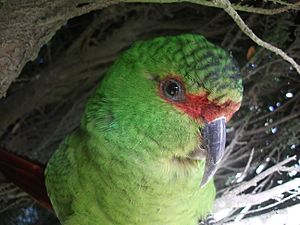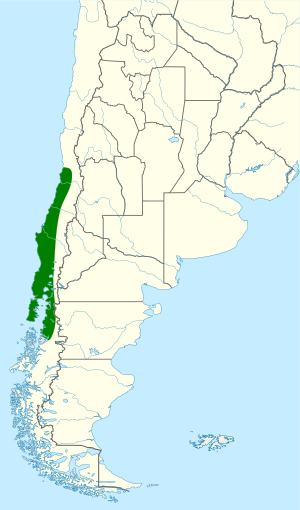Slender-billed parakeet facts for kids
Quick facts for kids Slender-billed parakeet |
|
|---|---|
 |
|
| Conservation status | |
| Scientific classification | |
| Genus: |
Enicognathus
|
| Species: |
leptorhynchus
|
 |
|
| Approximate range in green | |
The slender-billed parakeet is a special type of parrot found only in Chile. Its scientific name is Enicognathus leptorhynchus. In Chile, people often call it choroy. It belongs to the parrot family, which includes many colorful birds from Africa and the Americas. This unique bird is known for its long, thin beak.
Contents
About the Slender-billed Parakeet
What's in a Name?
Scientists give every animal a special two-part name. For the slender-billed parakeet, its scientific name is Enicognathus leptorhynchus. It was once called Enicognathus byroni, but leptorhynchus was chosen because it was named first. This bird is in the same group, or genus, as the austral parakeet.
How to Spot a Slender-billed Parakeet
This parakeet is about 40 centimeters (16 inches) long. Both male and female birds look the same. They have a bright red forehead and red patches around their eyes. The rest of their face is yellow-green. Their back and upper body are a dull green.
Their belly is yellowish-green with a reddish spot. Their tail is also reddish. Their wings are mostly green, but the main flight feathers are bluish-green. Young parakeets look similar to adults. However, they are a darker green and have whitish skin around their eyes.
Where Slender-billed Parakeets Live
Chile's Unique Parrot
The slender-billed parakeet lives only in central Chile. You can find them from the Santiago area down to the Los Lagos Region. They are sometimes seen in the Aysén Region, but this is rare. Very occasionally, one might fly into Argentina.
Favorite Places to Live
These parakeets mostly live in forests. They love forests with southern beech trees and Chilean pine trees. They also visit nearby open areas, ranchlands, and farms, especially in winter. They can live in high places, up to 2,000 meters (6,500 feet) above sea level.
Slender-billed Parakeet Behavior
Seasonal Movements
Slender-billed parakeets move around during the year. In the colder months, from May to September, they fly from higher mountain areas to lower lands. This helps them find food and warmer places.
What They Eat
These parakeets eat many different things all year long. Their diet includes grass seeds, thistle seeds, buds, and berries. In autumn, they especially love the large seeds from Chilean pine trees. Their unusual long beak is perfect for getting these seeds out! They also eat seeds from southern beech trees at other times. Sometimes, they eat crops on farms, especially on Chiloé Island.
Reproduction and Life Cycle
Slender-billed parakeets lay their eggs between November and February. They usually build their nests inside tree holes. If a hole is too deep, they add twigs to raise the floor. Sometimes, many pairs of parakeets will nest in the same tree. They can also use cracks in rocks for nests.
One nest was found with 10 eggs, but scientists think two females might have laid them. Another nest had five eggs. The eggs hatch after about 26 to 28 days. The young birds are ready to fly about 42 to 45 days after they hatch.
How They Communicate
The most common sound the slender-billed parakeet makes is a "nasal grating note." It sounds like "grrreh-grrreh-grrreh..." and they often repeat it many times. They also make higher-pitched, more musical screeches, like "kreeh!" or "kerreh!".
Slender-billed Parakeet Status
How Healthy is the Population?
The IUCN (International Union for Conservation of Nature) says the slender-billed parakeet is a species of "Least Concern." This means they are not currently in danger of disappearing. They live in a fairly large area, and even though we don't know their exact numbers, scientists believe their population is stable.
There are no immediate threats to these birds. In the 1950s and 1960s, their numbers went down because of trees being cut down. However, they are still quite common today. These parakeets like to be in groups and often sleep together in large roosts. Some roosts have had as many as 2,000 birds!
See also
 In Spanish: Choroy para niños
In Spanish: Choroy para niños


